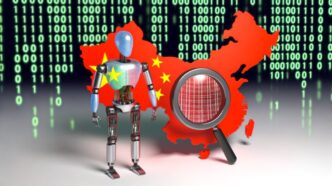A newly leaked database reveals how China is using advanced AI to tighten its grip on online speech. Marking a disturbing shift in the evolution of censorship. At the center of this development is a powerful large language model (LLM) trained to identify and flag content the government deems politically or socially sensitive. Content that ranges from criticism of corruption to complaints about rural poverty.
The leak, obtained by TechCrunch, shows that the Chinese government or its affiliates have developed a system that goes well beyond traditional keyword blocking. Instead, it leverages generative AI to evaluate over 133,000 examples of politically charged content. These include posts about corrupt Communist Party officials, suppressed protests, and even subtle political metaphors.
According to Xiao Qiang, a censorship researcher at UC Berkeley who reviewed the data, the goal is clear. To improve the efficiency and depth of China’s state-led information control. “Unlike traditional censorship systems that rely on human reviewers and fixed keywords. AI censorship in China is evolving to detect nuance and context. This makes it far more dangerous,” Qiang said.
The leaked dataset was discovered by a cybersecurity researcher known as NetAskari. Who found it on an unsecured Elasticsearch database hosted on a Baidu server. While there’s no evidence Baidu was directly involved, the contents reveal how the AI system works. Entries are tagged with instructions resembling ChatGPT prompts, directing the model to find anything related to “political satire,” “Taiwan politics,” “military movements,” and “social unrest.”
Even vague or metaphorical expressions are fair game. One flagged example includes a user using the phrase “When the tree falls, the monkeys scatter,” an idiom referencing the fragility of political power. Others speak to real-world issues: a small-town business owner complaining about being extorted by police. Or rural citizens describing their dying communities filled only with the elderly and children.
These are not isolated examples. Mentions of Taiwan alone appear more than 15,000 times in the dataset. Anything that risks sparking public outrage—whether about pollution, financial fraud, or food safety—gets flagged as high priority.
Although the dataset doesn’t name its creators, its stated purpose is “public opinion work”. A term widely associated with China’s online propaganda and censorship programs. Michael Caster, from the digital rights organization Article 19, explained that this phrase is closely linked to the Cyberspace Administration of China (CAC), which oversees digital content regulation.
Chinese president Xi Jinping has described the internet as the frontline for managing public opinion, reinforcing the idea that tech is now central to the Chinese Communist Party’s censorship strategy. The leaked AI system appears built to serve this exact mission—ensuring government narratives dominate online, while dissent is systematically scrubbed.
This isn’t the first time China’s use of AI for repression has come under scrutiny. In February, OpenAI reported that Chinese-linked entities were using LLMs to track dissent on social media and smear high-profile critics like Cai Xia, a former Communist Party insider turned outspoken dissident. Their AI tools not only monitored activists but also generated content to discredit them.
Traditionally, China relied on simpler tools to block keywords like “Tiananmen massacre” or “Xinjiang camps.” But today’s LLMs offer more power. They can detect subtext, sarcasm, and even indirect criticism—skills that allow them to flag content a human or basic algorithm might miss.
“This new AI-driven censorship model is much more adaptive,” Qiang warned. “It’s a chilling sign of how authoritarian regimes can use cutting-edge AI to control speech at scale.”
As Chinese models like DeepSeek and others continue gaining technical ground, the risks extend beyond China’s borders. Similar tools could be exported, copied, or adapted by other governments looking to suppress dissent more efficiently.
The leaked dataset shows how easily LLMs can be trained not just for productivity or creativity—but for surveillance, censorship, and control. It raises urgent questions about how AI should be regulated and whether the global tech community is doing enough to prevent these tools from being weaponized.
As generative AI spreads, so does the potential for abuse. And in China, that future is already here.













